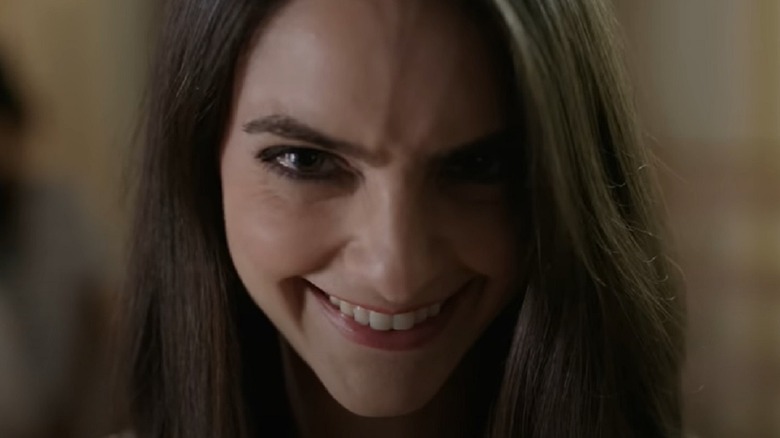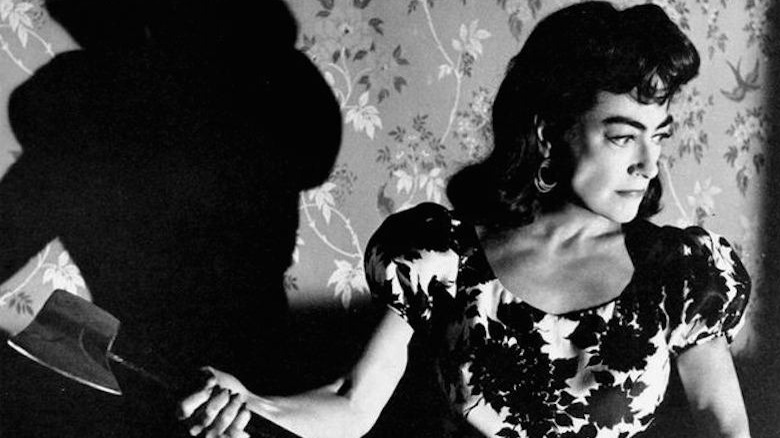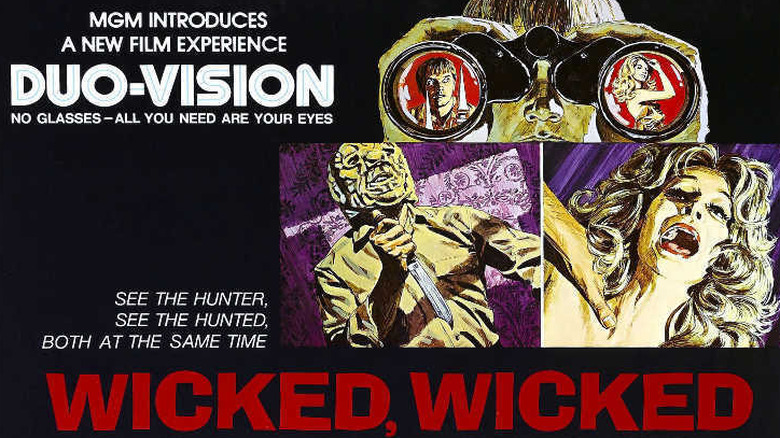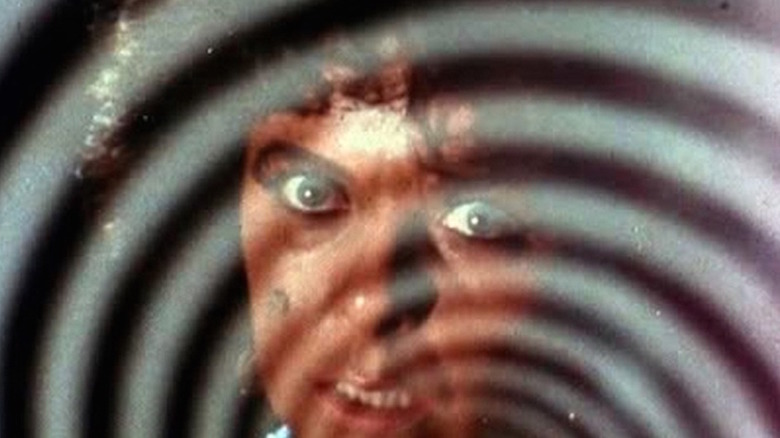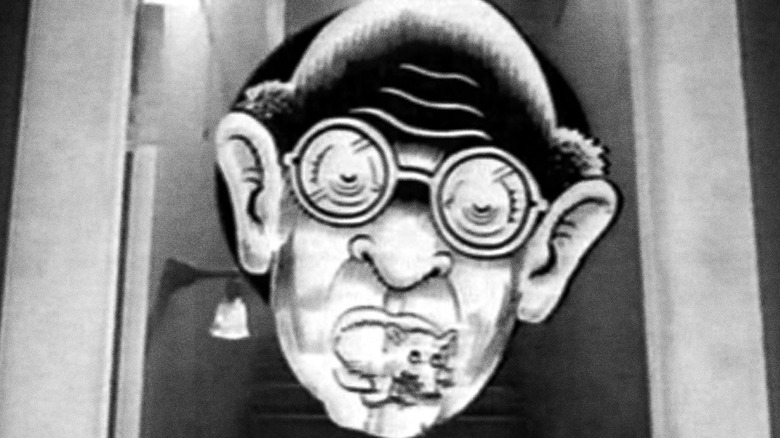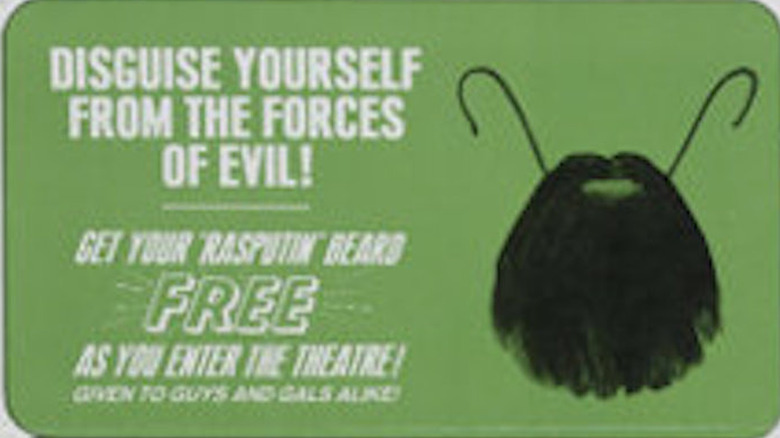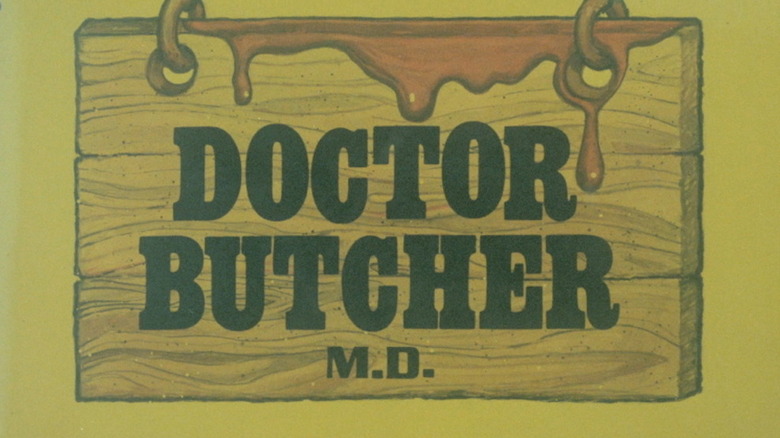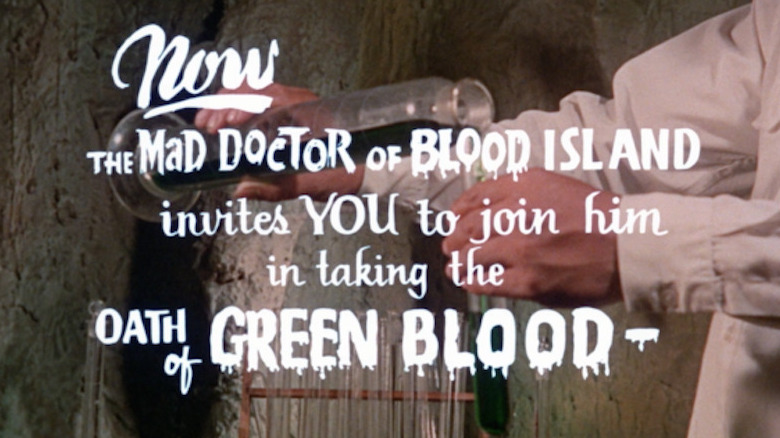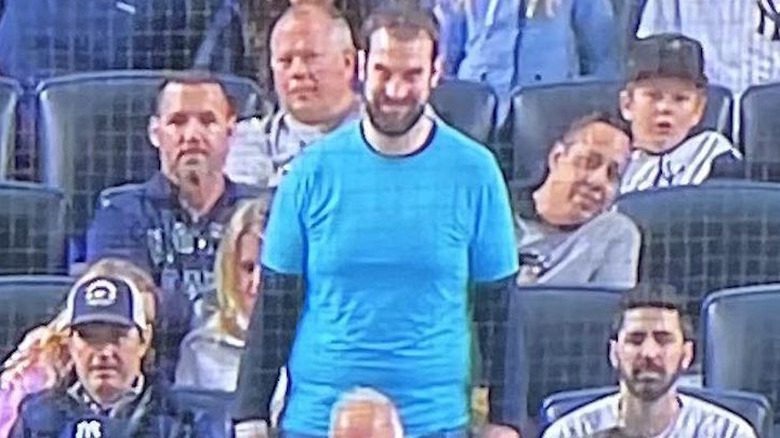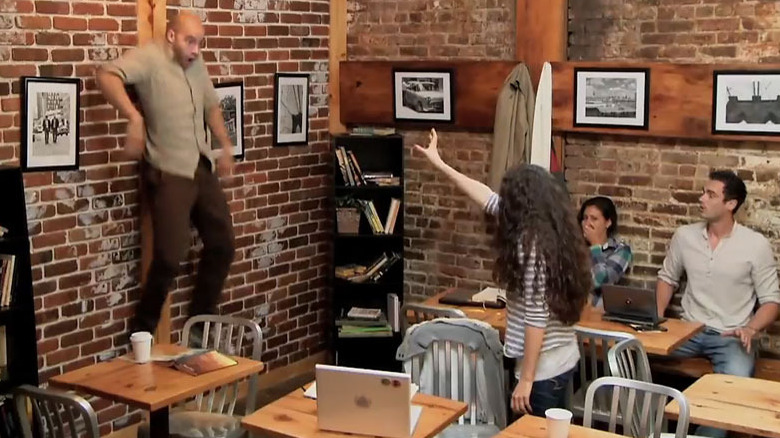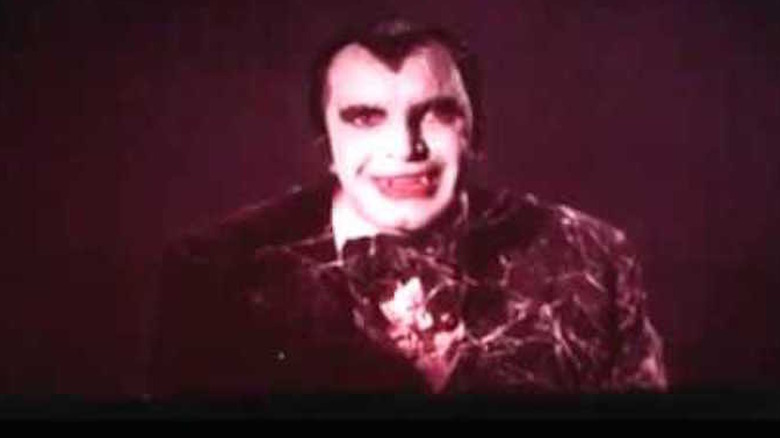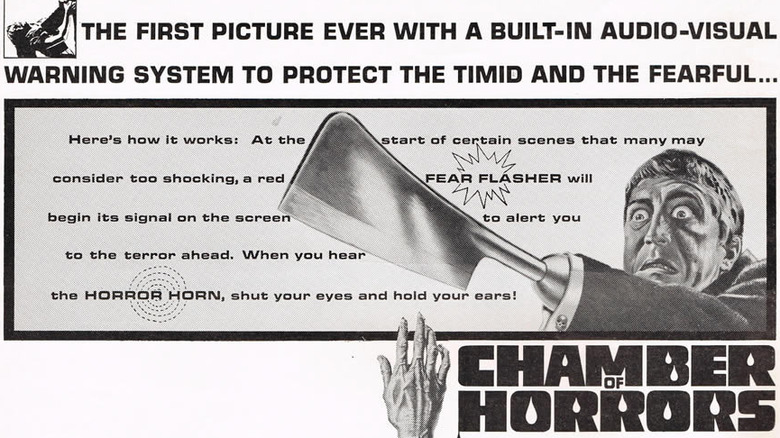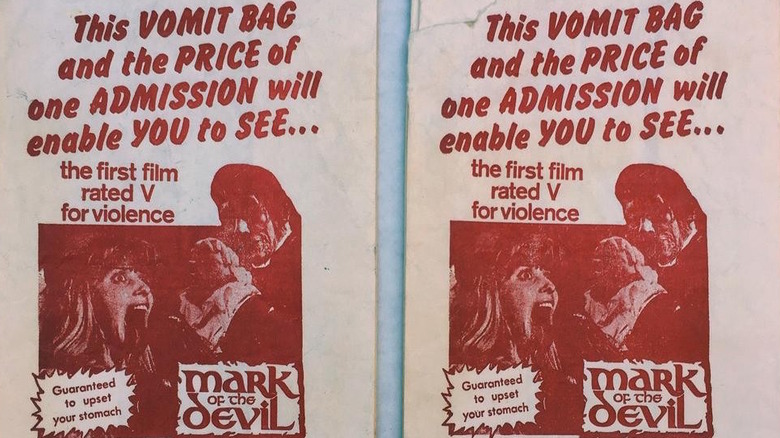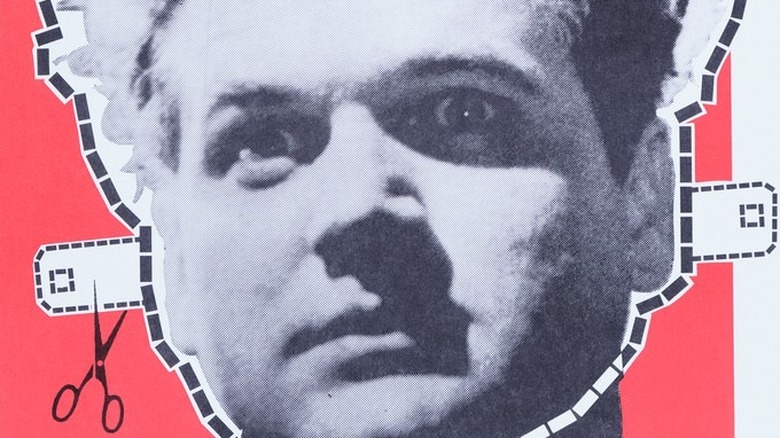Weirdest Gimmicks Used To Promote Horror Movies
Note to aspiring horror filmmakers: There are essentially four ways that you can get moviegoers to see your brand new fright flick. You can make it very scary, like "The Exorcist" or "Hereditary," or load it with wall-to-wall gore, as the crew behind the "Terrifier" films have done. Outrageous is always a good approach, and you can make it outrageous and clever (see: Sam Raimi's "Evil Dead") or outrageous and ... well, more outrageous (i.e., "Mandy," "Willy's Wonderland"). And if all of these methods fail, you can always fall back on one of the most tried and true methods: a good gimmick.
The history of horror movies is filled with titles that lured audiences into seats with gimmicks and come-ons that always seemed to fall just short of delivering their sensational promises: no late admissions to "Psycho," a punishment poll that allowed viewers to decide the fate of William Castle's "Mr. Sardonicus," and free surgical masks ("to keep the blood off your face"!) for attendees at screenings of "Basket Case." Some gimmicks were brilliant, some were deceptive, and some were inspired but entirely bizarre ways to promote a movie. Following is a spoiler-heavy list of the latter: the wildest, weirdest gimmicks used to promote horror movies.
Not all of William Castle's gimmicks were memorable
As the producer and/or director of such cult horror favorites as "The Tingler," "13 Ghosts," and "House on Haunted Hill," William Castle's success was measured less by how scary his films were than by the outrageous gimmicks he used to promote them. Castle wired a life-sized skeleton to fly over the heads of audiences watching "Haunted Hill" and attached vibrating motors to their seats that, along with on-screen prompting by star Vincent Price, spurred them to scream for their lives (or for the fun of it) at screenings of "The Tingler."
Castle kept promoting his films with gimmicks throughout the 1960s, but not every stunt had the lasting appeal of the tinted glasses that allowed you to see the titular spirits in "13 Ghosts." In his enjoyable autobiography, "Step Right Up! I'm Gonna Scare the Pants Off America," Castle wrote that despite retaining Hollywood Golden Age star Joan Crawford to play an axe murderer in 1964's "Strait-Jacket," he couldn't resist throwing a gimmick into the mix. Unfortunately, the best he could come up with were cardboard axes stained with fake blood.
He found himself in a similar quandary for his 1975 production "Bug," which concerned fire-spewing cockroaches from the bowels of the earth. Unable to bring a string of ideas to pass — including a floor-mounted device that simulated the sensation of bugs crawling up viewers' legs — he publicly took out a $1 million insurance policy on one of the on-screen insect actors named Hercules. The gambit did not work and "Bug" was a bust.
Duo-Vision made Wicked, Wicked into two horror movies
Believing that the future of motion picture entertainment lay in providing an audience with too much information, veteran television director Richard L. Bare filmed MGM's 1973 psycho-thriller "Wicked, Wicked" entirely in split screen, an optical process which showed two (or more) separate moving images simultaneously on a divided screen. The process had been used in feature-length projects prior to its release, most notably in experimental films like Paul Morrissey and Andy Warhol's "Chelsea Girls." But Bare, who also wrote and produced "Wicked, Wicked," used the process, which he dubbed Duo-Vision, to detail a psychopath targeting blonde guests at a grand California hotel (the Hotel de Coronado, where Billy Wilder shot "Some Like It Hot").
Though Bare used the split-screen in inventive ways — like showing both sides of a scene at once or a character discussing his actions on the left side of the screen and showing them to be the opposite on the right — most critics and audiences found the gimmick tiresome (it holds a 26% audience response on Rotten Tomatoes) and the movie itself too inconsequential. "Wicked, Wicked" fell into near-total obscurity for decades until a revival by Turner Classic Movies' TCM Underground showcase in 2008.
Several '60s horror movies wanted to hypnotize you
While the prospect of being hypnotized as part of a moviegoing experience seems at best unsettling and at worst illegal (it isn't, but some states have regulations), no less than four low-budget horror movies tried to lure in audiences with the promise of having their thoughts and actions under someone else's control. For their release of the 1959 British creepshow "Horrors of the Black Museum," American International Pictures added Hypno-Vista, a 13-minute prologue featuring hypnotism expert Dr. Emile Francel, who delivers a stilted monologue on suggestion between simple experiments using color changes and shots of a hypnotized woman with needles through her arm.
A year later, Allied Artists introduced Hypnomagic, the "thrill you SEE and FEEL," in their creepy-sleazy 1960 feature "The Hypnotic Eye." Like Hypno-Vista, this was a standalone element within the movie itself, with "Hypnotic Eye" star Jacques Bergerac involving the audience in his on-screen hypnosis stage act. An article on the film in a 1960 issue of FIlmFacts (via the American Film Institute) encouraged theater owners to turn up the house lights during this scene to encourage audience participation. The "Hypnoscope" employed by American distributor K. Gordon Murray for his double bill of two dubbed Mexican monster movies ("The Vampire's Coffin" and "The Robot vs. the Aztec Mummy") featured a ever-looping hypno wheel while a narrator extolled the "Young America Mystic Cult of Horrors."
But nothing beat "Hallucinogenic Hypnovision," a trance-inducing gimmick used for Ray Dennis Steckler's 1964 cult wonder "The Incredibly Strange Creatures That Stopped Living and Became Mixed-Up Zombies." Though Hypnovision its was just a black-and-white hypnowheel that appeared on screen, its appearance signaled a horde of costumed creatures – played by the theater's ushers or Steckler and friends — to run amuck in the audience!
Psycho-rama tried to scare you subliminally
Movies have made use of subliminal imagery for decades; some of the best-known examples include "The Exorcist," "Cloverfield," "The Ring," and (reportedly) "Midsommar." But only two have used the process, also known as psychorama, as a selling point: 1958's "My World Dies Screaming," which was late retitled "Terror in the Haunted House," and 1959's "Date with Death," both directed by low-budget specialist Harold Daniels. Both used a subliminal process – also called Psycho-Rama – which featured images which flash over the action in the film, and which were intended to heighten audiences' emotional response to the scene.
Unfortunately, neither the films nor the subliminal messages can generate any responses beyond gales of laughter or total indifference. "Terror" is a sludge-paced chiller about a couple who move into a house that appears in the wife's recurring nightmares, while "Death" is a forgettable crime picture about a drifter who becomes a small-town sheriff. To make either of these films remotely interesting, Daniels would have needed some overwhelming images, but the best audiences get are blurry cartoons of (among other things), a long-tongued devil, a skull with googly eyes, random text ("Scream bloody murder!"), and most curious of all, a jug-eared guy wearing Coke bottle glasses and with a rat in his mouth.
Hammer horror was promoted with X-ray glasses and fake bears
England's Hammer Films earned a reputation in the 1950s and 1960s for producing a string of horror features (among many other films) that combined Gothic atmosphere with liberal lashes of blood and sensuality. Their takes on classic movie monsters like Dracula, Frankenstein, and the Mummy were and remain beloved by genre fans, but with modest budgets and no major stars — leads Christopher Lee and Peter Cushing were decades away from "Star Wars" and "The Lord of the Rings" — American distributors like Warner Bros. relied on gimmicks to lure in audiences.
To promote Lee's second outing as Dracula in 1965's "Dracula, Prince of Darkness," Warner bundled the film in a double bill with another Hammer film, "The Plague of the Zombies," and promised freebies for attendees: plastic vampire fangs for the boys ("Fight back! Bite back!" urged the posters) and "zombie eyes" (3-D-style viewers with hypnotic spirals in the lenses) for the girls. However, this two-fer paled in comparison to Fox's gimmicks for the double bill of Hammer's "Rasputin, The Mad Monk" and "The Reptile": a "genuine" Rasputin beard, given to boys and girls alike to protect them "from the forces of evil." Fox's rationale for sticking kids with Old World/hillbilly/hipster facial hair? As the pressbook noted, "Youth today are particularly susceptible to weird hairdos and the beatnik look."
The Butchermobile terrorized New York City
If you haunted drive-ins and grindhouses in the 1970s and 1980s, chances are that the strongest and strangest material you saw unspool on screen was distributed by the New York-based Aquarius Releasing, Inc. Terry Levene's outfit handled just about every type of exploitation flora and fauna, from martial arts films and softcore to mondo movies, Italian crime pics, and horror films from all points on the globe. Aquarius created eye-popping promotional material for their releases, but few became the stuff of cult movie legend like their campaign for 1982's "Dr. Butcher, M.D."
Released in 1980 as "Zombi Holocaust," the gory Italian zombie-cannibal fusion was rechristened with the "Dr. Butcher" moniker by Levene, who also added footage from an unrelated horror film by documentarian Roy Frumkes. He also festooned a flatbed truck with medical equipment, and tapped marketing consultant Gary Hertz, then at New Line Cinema, to portray the good doctor, who would "operate" on a victim (played by legendary zine maven Michael J. Weldon of "Psychotronic" fame) while fellow zine publisher Rick Sullivan shouted to astonished passers-by in Manhattan and the outer New York boroughs.
Enjoy some green blood with the Mad Doctor of Blood Island
Devotees of '70s-era horror and exploitation hold a special place in their hearts for Hemisphere Pictures' "Blood Island" films. The quartet of low-budget horror films — "Terror is a Man" (1959), "Brides of Blood" (1968), "The Mad Doctor of Blood Island" (1969) and "Beast of Blood" (1970), all lensed in the Philippines — each concern diabolical science on the titular tropical paradise, liberally spiced with gallons of gore and human-plant hybrids with chlorophyll in their veins. Hemisphere also promoted the Blood Island pictures with outrageous promotional campaigns, including a prologue for "Mad Doctor" that encouraged viewers to guzzle what was advertised as green blood.
The blood was actually colored liquid in packets that were given to ticket holders before each showing of "Mad Doctor." The prologue's narrator then rambled at length about the secret powers of the green blood, including sexual arousal and awareness of "a supernatural consciousness." Its primary purpose was to indoctrinate audiences into the "Order of Green Blood" by reciting an oath that would protect them from the "unnatural green-blooded ones without fear of contamination." Unfortunately, the latter may have been what some moviegoers got with their blood packets: in Fred Olen Ray's The New Poverty Row: Independent Filmmakers as Distributors, producer Sam Sherman, who created the "Order of Green Blood" spot, reported that he became violently ill after consuming one of them
Real-life smilers were almost as scary as the movie
There are a lot of downright disturbing images in Parker Finn's 2022 feature "Smile," but none so guaranteed to send a shiver down your spine as the joyless and predatory grin displayed by those possessed by the "Smile" monster: a demonic entity with a boundless appetite for those in the grip of trauma. Paramount's marketing team seized upon that skeletal grin to promote "Smile" through a series of extremely clever and unquestionably creepy viral marketing opportunities.
The studio dispatched actors to photobomb locations with high visibility, such as several Major League Baseball games and even a segment with Al Roker on "The Today Show." The image of these performers – who remain motionless for long periods of time with a ghastly smile pasted on their faces – quickly made the rounds on social media, which provided the film with crucial word of mouth prior to its release. Paramount has kept up the campaign as "Smile" travels to international markets: The studio teamed with the Hello Social marketing agency to place "smilers" at locations in Sydney, Australia, and even upped the ante by sending them in packs to office buildings, shopping malls, and on public transport.
A Carrie remake wreaked havoc in an NYC coffee shop
It's one thing to promote a movie with an eye-popping poster or wild trailer, and another to draw in audiences with a gimmick like green blood or ghost viewers. And it's an altogether different kind of promo when it's a live event that seems to defy the laws of science and reason. But that's exactly what unsuspecting patrons of the 'Snice Coffee Shop in Manhattan's West Village experienced in 2013 as part of Sony's promotion for Kimberly Peirce's remake of Stephen King's "Carrie."
Viral video marketing agency Thinkmodo created the prank, which earned nearly 51 million views on YouTube in 2013 alone. They used hidden camera footage to capture the shocked reactions of the shop's patrons when a woman, enraged by a man who spilled coffee on her computer, appears to use telekinesis to hurl him against a brick wall. Books and tables in the show also appear to move on their own, sending some patrons into hysterics and others for the door. The entire "attack" was orchestrated using a fake brick wall, wires attached to the man, and remote controlled tables.
Horroritual inducted audiences into the Count Dracula Society
To promote "Dracula A.D. 1972" — the penultimate film featuring Christopher Lee as Dracula from Hammer Film Productions — in the United States, Warner Bros. decided that audience involvement was the solution to flagging audience attendance for the series. Stateside moviegoers were shown a short film titled "Horroritual" (known alternately and informally as "The Oath"), which featured a cobweb-draped vampire who urged them to pledge loyalty to the Count Dracula Society ("so help me, Christopher Lee"), much in the same manner as the Order of Green Blood's oath.
Attendees were given a card signifying their membership to the society, which was a real organization, overseen by Dr. Donald A. Reed, who later expanded the group into the Academy of Science Fiction, Fantasy and Horror Films, home of the Saturn Awards. Playing the on-screen, Lugosi-accented vampire was actor Barry Atwater, who essayed another memorable bloodsucker in "The Night Stalker" – which introduced Darren McGavin's Carl Kolchak – that same year.
The Fear Flasher and Horror Horn warned viewers about Chamber of Horrors
According to Variety (via the American Film Institute), the 1966 chiller "Chamber of Horrors" was originally intended as a pilot for a series titled "House of Wax," and reportedly drew its inspiration from the 1953 Vincent Price film of the same name, before Warner Bros. released it to theaters. Cesare Danova ("Animal House") and Wilfred Hyde-White ("Buck Rogers in the 25th Century) starred as 19th century wax museum owners turned amateur sleuths who pursued a psychotic killer (Patrick O'Neal) that dispatched his enemies with an array of sharp implements attached to his severed hand.
Given its small screen origins, "Chamber of Horrors" isn't particularly frightening, though its script lends an air of sexual sadism to O'Neal's behavior. Perhaps concerned about its lack of scares, the producers added a novel if somewhat goofy gimmick to the opening of the film. The unmistakable voice of William Conrad advised viewers that they would be alerted to upcoming moments of terror with audio-visual elements: a flashing red light called the "Fear Flasher" and a siren (that sounded like a cue from Hanna-Barbera's library of sound effects) called the "Horror Horn." The warning had an entirely opposite effect on viewers: as a reviewer from the LA Times (via the American Film Institute) noted, the film like "watching Frankenstein peel an orange."
Terrifer 2 continues the tradition of vomit bags as movie promotion
Nothing quite delivers the message that a horror movie will not only scare but also disgust you like an airline sickness bag given out at every screening. Once a staple of down-and-dirty '70s grindhouse titles like "Mark of the Devil," the practice has been revived recently for the French cannibal movie "Raw" and "Terrifier 2," which reportedly caused audience members to pass out and in some cases, lose their lunches. As a result, theaters have been armed with barf bags to distribute before showings.
The history of promoting movies with vomit bags is an imperfect one: "Blood Feast" producer David F. Friedman is alleged to have started the trend by providing patrons with stomach distress bags before viewing that pioneering gore film in 1963. Many horror history sources cite the Boston-based distribution company Hallmark Releasing Corporation as one of the first to popularize the practice when they armed theatergoers with airline sickness bags in order to see their 1972 release, the German witch-hunting film "Mark of the Devil." That effective bit of ballyhoo has been reproduced countless times in subsequent decades, with films ranging from "Cannibal Ferox" and Peter Jackson's "Bad Taste" to Alexandre Aja's remake of "The Hills Have Eyes" all employing barf bags to help sell their accompanying feature as the ultimate gross-out.
Need an Eraserhead mask? A24 had one
Though many of the gimmicks mentioned here were used for their accompanying films' first Stateside theatrical run, the "Eraserhead" cut-out mask appears to have been used for midnight screenings of David Lynch's groundbreaking surreal nightmare after its release in 1976. A 2021 auction of promotional movie items by the production company A24 ("The Whale," "X") included an oversized photograph of star Jack Nance that one could (if so inclined) cut out and wear as a mask. The mask featured helpful dotted lines for a clean cut, and even tabs for tying the mask to your face with string. Though the A24 site dates the mask back to 1997, other online sources claim that the cut-out was given out at screenings in the 1980s.
It's too late to buy the mask, which sold for $400, but it's worth noting that at least a third of the mask is taken up by Nance's skyscraper hairdo, which may have proven unwieldy for the wearer (especially in a high wind). It also appears that the mask lacked eyeholes, as Nance's eyes appear intact in the photo. To quote A24's listing, this last detail makes the "Eraserhead" mask "the definition of Lynchian."
